For Your Safety - Screening, masks, and sanitation will continue to be implemented at our facility. Please see our blog post for more information.
Two of the most frequently asked questions from physiotherapy patients are “how do I choose a pillow,” and “how do I choose a mattress?” Mattress and pillow shopping is confusing because there are lots of choices, but once you understand what the pillow or mattress should be doing for you then it is less painful to choose one. I’ll describe and show you in this article what to look for (and feel for). It’s also important to note that a proper pillow and mattress combination can help improve neck pain or back pain and quality of sleep.
When do I need a new pillow or mattress?
Mattresses are designed to last ten to twenty years. Pillows, however, wear out much sooner. The materials of both that help with support and cushioning lose their qualities over time. Even though it may look fine on the outside, the foam and materials of a pillow compress and lose their elasticity. The springs inside a mattress can also lose their spring and support. Here are some common symptoms to consider when considering if a pillow or mattress needs replacing and upgrading:
- Consistent waking in the night or morning with stiffness and pain in the shoulders or neck areas. Or waking with numbness and tingling in an arm, hand, leg or foot. These problems can slowly build up over time and start out in a subtle way.
- Difficulty getting comfortable in any position and restless poor quality sleeps.
- And it’s been so long you can’t remember when you bought your pillow, or maybe it came with the cottage or you inherited it!
Here’s some things to look out for in mattresses:
- The ability to feel coils and springs when a person moves around or creaking sounds are heard from the mattress.
- The mattress is sagging in the middle or has visible signs of wear on the top.
Neck and back problems are usually caused by a combination of factors including a poor pillow and mattress. A proper pillow is an easy factor to eliminate as one contributor to the overall problem. And sometimes it can be the main reason for the pain!
What should a pillow ideally be doing?
Both pillows and mattresses have two main purposes:
- To support and
- To cushion.
A pillow must provide both often by using only one type of material, for example foam, or a combination of materials such as foam and water.
1. The pillow and mattress should provide optimal support
That means that it should support and maintain the natural alignment and curves of the spine (neck, mid back and lower back) and hips (in the case of a mattress) whether a person is on their front, side or back. It’s important to understand the normal posture and alignment of the spine when looking from the side as compared to looking from the front or back. The natural posture of the spine is as follows. When looking from the side, the neck (cervical spine) curves forward towards the throat. The midback (thoracic spine) curves backwards and the low back (lumbar spine) curves forward towards the stomach. See diagram below:
Diagram 1
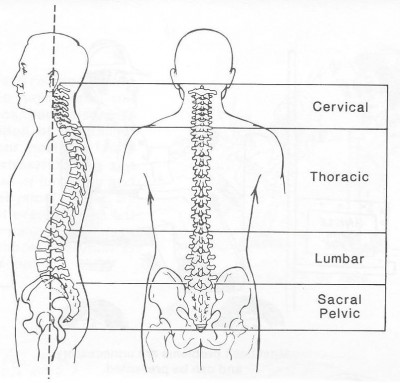
With proper alignment and good posture the head sits directly on top of the shoulders, not poking forward as if to guide a person around corners.
When looking from the back the spine should be straight and perfectly vertical with no curves. See diagram above.
Side Sleeping
Now let’s look at how the mattress and pillow should support the natural spinal curves and alignment by looking at a person on their side lying on the floor. In picture 1 below, the spine is normally aligned as shown with the black line. The back and neck are lined up as if the person was standing. Note that the space between the ribs and the hip indicated by the arrow should be filled in with the support from a good mattress. And the space between the neck/head and floor is filled in with the pillow.
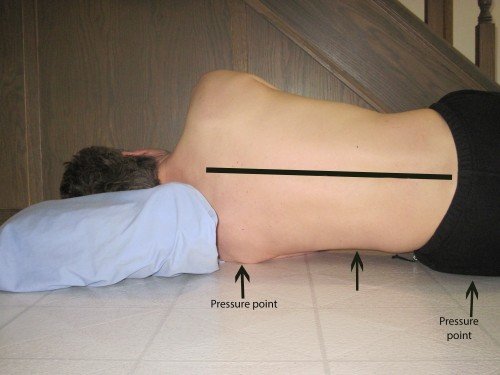
Picture 1
A proper pillow will keep the head and neck lined up in a natural and neutral position. This is where the head, neck and back all line up in a straight line.
Notice in picture 2 below that the black line outlines where a proper pillow support fills in the space between the head, face, neck and the mattress. The pillow follows the body shape in three dimensions to keep a straight line between the head, neck and hips. A proper mattress will allow the body to sink into it just enough to allow the natural position of the spine to be supported as shown in picture 2 below:
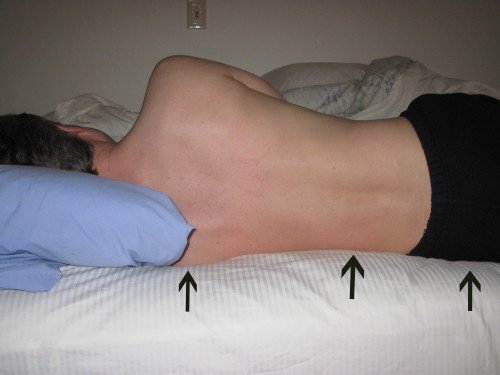
Picture 2
Now let’s see what happens when no pillow is used and we’ll pretend the floor is a hard mattress for the purposes of this description. In picture 3 below, this person is lying on their side, relaxed on the floor, to demonstrate what would happen if they were sleeping with no pillow on a mattress that was very hard and firm.

Picture 3
Notice that the black dots outline the back and neck. The head is side bent and turned causing the neck to also twist, bend and curve towards the floor out of its natural alignment without pillow support. The hips and the shoulders are not able to sink into the floor (mattress) and the spine sags down towards the floor when they relax. Without a proper pillow and a hard mattress the spine is not supported properly. This will cause an uncomfortable sleep and over time can lead to pain, stiffness and injury. The muscles and ligaments in the neck are put on an unnatural stretch for hours at a time leading to strain and sprain. The other problem is that there is more pressure on other areas of the body like the shoulders and hips, creating pressure points because the weight of the body is not dispersed well. (see picture 1 above)
With a pillow that is too soft, too thin, and not shaped properly – and a mattress that is too soft – to the head and neck a similar effect happens. The neck and head twist and bend out of their natural ideal position and posture. And the hips, shoulders, and spine sag into the mattress too far not providing enough support. Again the spinal curves are not supported in their proper alignments. A strained position similar to the picture above will result in pain, stiffness and injury. It will also lead to a restless sleep.
A pillow that is too hard, thick or the wrong three dimensional shape will also result in the neck and head being held in a position that is unnatural and a high strain posture.
How much firmness, thickness and shape and overall support is required will depend on an individual’s weight, three dimensional body shape and personal preference.
Pillows and mattresses are like a shoe. Ten people may be the same length and width for a walking shoe, but they all prefer and need a different model. I’ll discuss more on choosing a pillow and mattress below.
Back Sleeping
Pillows
For back sleepers the pillow needs to support the natural curve of the neck while cradling the head all in a neutral and natural alignment. See picture 4 below. A proper alignment means the ear opening/canal is lined up with the tip of the shoulder like the straight black line. The thickness, shape and firmness of the pillow with determine how the head and neck are positioned. A proper pillow will follow the shape and contour of the black line below filling in the space between the neck and the mattress (floor). It also allows the head the sink into the pillow to provide a depression for the head to be cradled in.
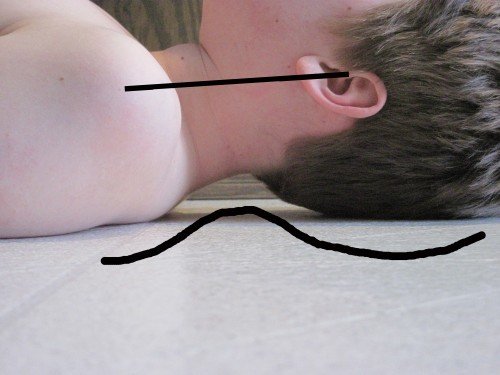
Mattresses
When sleeping on the back, let’s look at how the mattress should support the natural spinal curves and alignment by looking at a person lying on the floor. In picture 4.1 below, the spine is normally aligned. Note that the space between the ribs and the hip indicated by the arrow should be filled in with the support from a good mattress.
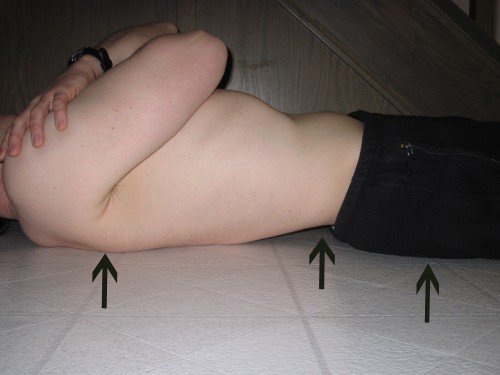
Picture 4
A proper mattress will allow the body to sink into it just enough to allow the natural position of the spine to be supported as shown in the below picture 4.2:
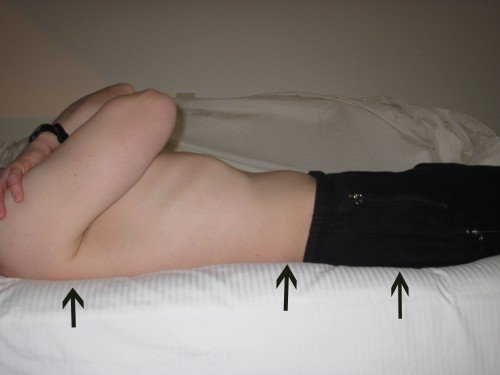
Picture 4.2
Again, let’s pretend the floor is a hard mattress for describing when a person sleeps on their back. Notice that the black line outlines the spine and it is curved towards the floor out of its natural alignment in picture 4.3 below. The hips and shoulders are not able to sink into the floor (mattress) and the lower back sags with gravity onto the floor.
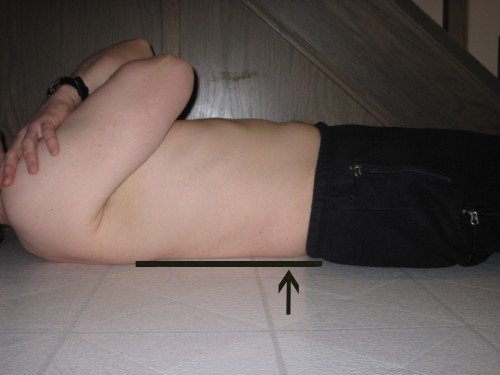
Picture 4.3
Therefore, the hard floor (hard mattress) does not support the spine properly. This will cause an uncomfortable sleep and over time can lead to pain, stiffness and injury. The other problem is that there is more pressure on other areas of the body like the shoulders and hips because the weight of the body is not dispersed well.
Again, with a mattress that is too soft a similar effect happens. The hips, shoulders, and spine sag into the mattress too far not providing enough support. Again the spinal curves are not supported in their proper alignments. On a soft mattress, however, there would be better spreading of pressure points in comparison to a hard mattress.
2. The second important pillow and mattress function is cushioning
Some popular materials used for cushioning in a pillow can be foam, gel, feathers, water, or padding of many types in layers. The various materials used for cushioning over top of the mattress coils and springs can be foam, memory foam, gel, and padding of many types layered on top. The cushioning is meant to spread and disperse pressure from prominent and pointy areas of the head, face and body.
Cushioning for Pillows
A pillow must provide both cushion and support using one or two types of material. Cushioning is not the same as support. For example, lying on a rectangular pillow of puffy foam will provide excellent cushioning but not ideal support. This is because the foam will compress and deform under the weight of the head too much to create proper support. It will feel good initially but a person will sag and twist into the pillow as the night goes on and eventually lead to soreness and stiffness. Cushion and support are equally important.
Cushioning for Mattresses
A mattress should cushion the shoulders, hip and ribs if lying on the side. If lying on the back, the shoulder blades, spinal bones, ribs and tail bone should be cushioned. The cushioning layers also work along with the springs and coils to provide support. The quality of the cushioning layers is important. High quality foam will last longer and provide great cushioning and support.
Extra puffy low quality foam layers will feel good initially, but a person will sag into them and wake up sore and stiff. For example, lying on a bed of rose pedals 3 meters thick will provide lots of cushion but little support. The mattress top needs to give and shape to you but also provide a base of support. The top layers and springs/coils work together to hold you in a proper posture. Much like a shoe has padding on the inside but the sole underneath it is more rigid and firm.
Final Thoughts and Recommendations on Pillows
What pillows give the best support and cushioning?
I hope at this point the purpose of a pillow and what it should be ideally doing is clear. But what products are out there that work well? I’m asked everyday by patients which pillows do I recommend. Over the past 22 years I’ve listened and learned from patients and my own experience and training. If the pillow follows the principles I have described above that is the key. Where it gets tricky is that personal preference is a big factor. The same great supportive pillow may have a different feel for ten different people. That’s because the human shape has an infinite number of combinations and you guessed it, we’re all unique.
- The pillow has to have optimum support and cushioning following the principles of this article.
- If you have a large budget and are willing to try several pillows, eventually you will find the ideal one.
But most people need to have the best chance at a pillow with one purchase so……
- The more customizable the pillow the better!
What do I mean customizable? The more options to adjust a pillow to your shape and level of support the better. The most successful pillow I have recommended has been the Mediflow ™ water based pillow shown below. This is not an advertisement but an objective observation. I have recommended it for 14 years now and I have had 70-80% people report improved sleeps and reduced neck discomfort using it. The other 20-30% have noticed no changes.
The mediflow ™ pillow has a water chamber covered in a foam top. See the picture below. It is customizable because more or less water can be added to its base (range is 2-5 litres) and it takes on a person’s unique shape and dimensions. It works when the weight of the head displaces the water as the head sinks in. The water pushes into the neck area along with the foam top, filling in the space between the neck and mattress and providing optimum support. Water seems to be an excellent base of support while the foam provides cushion. My theory is that water is a natural medium for support that it is very compatible with the body because the human body averages a total of 60-70% water content in muscle and other tissues.
Mediflow ™ water based pillow
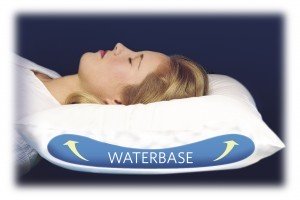
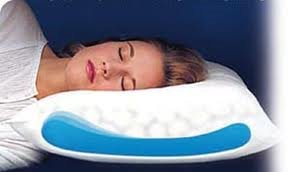
The Mediflow™ waterbase pillow is also one of the few if not the only pillow that has been shown to be effective in clinical research. In a 1997 John Hopkins University study, 3 pillows were compared with 41 subjects who had neck pain. They looked at the Mediflow ™ pillow, a roll pillow (shaped) and a regular foam pillow. The Mediflow™ pillow scored the best and was associated with improvements in the quality of sleep and modest improvements in pain levels. The roll pillow scored second best (find article at: www .mediflow.ca).
My second recommendation would be to try a McKenzie™ cervical roll inserted in a pillow case as shown below. It can be tried with a regular rectangular pillow or even with a Mediflow™ pillow for extra support.
McKenzie ™ neck roll

Finally, there are shaped and contoured foam pillows that can also be effective. But I have noticed that most patients have found shaped foam pillows ineffective or uncomfortable. I can only conclude that is because they are cut and shaped to the average human body shape and not adjustable or customizable. The principle, however, of how they are to work is logical. But of course no one is average. If you are able to try a “demo” shaped pillow in the store this may help to choose an appropriate one.
Tips For Buying a Pillow when you’re at the store:
- Many stores now have “demo” pillows you can try in the store. Lay down on the pillow and take the time to feel for the correct support and positioning of your neck. With the information above this should now be easier.
- Take this article with you pillow shopping as a reference to help you pick that ideal pillow.
Final Thoughts and Mattress Recommendations
Do I need a hard or soft mattress?
The answer should be clear at this point. It’s neither hard nor soft. It’s somewhere between. Just enough firmness to hold the spine in proper alignment and posture. (Diagram 1). The research proves this. A Spanish study published in 2003 in the British Medical Journal, The Lancet, involved delivering mattresses to 300 adults who complained of lower back pain. The volunteers were not told if they were receiving a hard or medium firm mattress. After three months the people who slept on the medium firm mattresses reported significantly less pain and used less painkiller medication than those with the hard mattresses. The old advice to use a hard mattress for a sore back simply does not make sense. Just looking at the person in Picture 3 above on their side will make you sore!
Some tips when you’re at the mattress store:
- Lay down on the mattress and take the time to feel for the correct support and positioning of your body. With the information above this should now be easier. Take a book with you, wear comfortable clothes and take your jacket off!
- Decide for yourself what firm or soft is. Of course the sales person’s advice can help guide you.
- Get a specifications sheet to compare design and materials for each mattress you look at.
- Buy the mattress and box springs as a set.
What position should I sleep in?
There is no correct position as far as the back is concerned. It is what is most comfortable. Sleeping on your side, back or front is fine. In terms of your neck, it is best to avoid front sleeping. As you have learned from the above information, the neck will have to be turned and bent out of a natural position if front sleeping, which causes strain. If you can’t break the habit of sleeping on your front, then use a thin pillow or none at all. Sleeping on your side, or back is ideal for your neck. If you have a shoulder rotator cuff problem, then lying on that side could be troublesome and ideally avoided.
I truly hope the information in this article is helpful for people when thinking of changing pillows or who are in the market for one. It’s a fact that 90% of people will experience neck and/or back pain in their life to varying degrees. Using a proper pillow and mattress is one way to reduce problems from developing and will help to reduce neck and back pain when present.
Kelly Milan, BMR,PT ©

